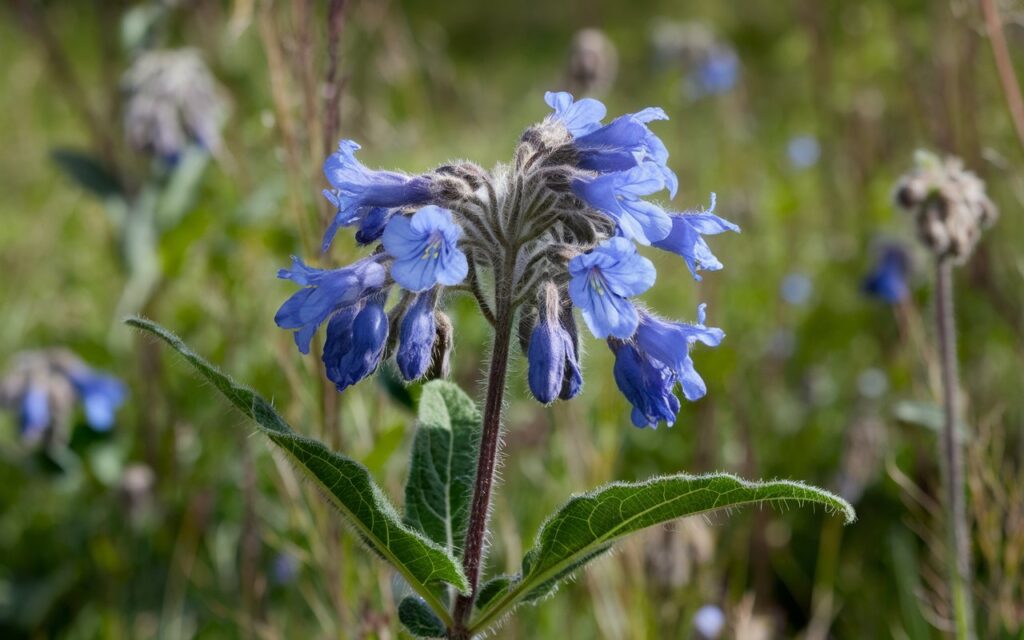Common Borage (Borago officinalis) is an annual herb often found in gardens. Not only is it valued for its medicinal properties, but it also attracts bees, which make excellent honey from its nectar.
Identification:
The entire borage plant has stiff white hairs covering it. Round, branched, hollow stems grow up to about 1 ½ feet tall. Its deep green leaves alternate in position, are wrinkled, oval, and pointed, each measuring about 3 inches long and 1 ½ inches across. The lower leaves have tiny hairs on their upper surface and veins on the underside. Additionally, the leaf margins are wavy but remain whole.
The vivid blue, star-shaped flowers have prominent black anthers that form a cone in the center, often referred to as a “beauty spot.” These flowers, which begin pink and turn blue, hang in clusters. The plant produces four brown-black nutlets.
Edible Use:
You can consume the leaves, flowers, dried stems, and seeds of borage, as they are all edible and nutritious. Eating the leaves raw or cooked adds a salty flavor, similar to cucumber, to salads or as a pot herb. It is best to use the leaves while young, as mature leaves become hairy, which some people find unpleasant.
The flowers make a beautiful garnish for salads and drinks. Furthermore, brewing the leaves as tea creates a refreshing drink. People often use dried stems for flavoring. While the seeds are a healthy source of gamma-linolenic acid (GLA), an Omega-6 fatty acid, gathering enough for regular use can be challenging.
Medicinal Use:
Regulates Hormones, PMS, and Menstrual Issues: Borage helps regulate hormones and metabolism, which can alleviate symptoms of premenstrual syndrome (PMS) and menopause. Additionally, it supports a regular menstrual cycle when consumed with meals.
Stress and HPA-Dysfunction (“Adrenal Fatigue”): Borage serves as a calming herb that helps relieve stress and balance cortisol levels, aiding in the stress response and addressing HPA-Dysfunction, often referred to as Adrenal Fatigue.
Anti-Oxidant Properties: The antioxidants in borage combat free radicals, protecting against aging and cancers caused by these harmful molecules.
Digestive Problems and Irritable Bowel Syndrome: Borage soothes the stomach muscles and helps treat irritable bowel syndrome. It also reduces inflammation in the intestines, promotes digestion, and has a mild laxative effect.
Pneumonia: Borage leaf and flower tea or tincture can reduce pneumonia symptoms, relieve congestion, and help the body eliminate excess mucus. However, other herbs may be more effective for these symptoms.
Mouth Ulcers and Sore Throats: Using borage as a mouthwash or gargle can kill bacteria in the mouth and throat, preventing and treating mouth sores and sore throats.
Urinary Tract and Kidney Infections, Diuretic Properties: Borage acts as a diuretic, removing excess water and toxins while improving bladder function. It also relieves bladder infections and kidney inflammation, although other herbs like Usnea, Oregon Grape, and Uva Ursi might be preferable for these conditions.
Protects the Brain: The GLA in borage seed oil protects the brain from neurodegeneration, including synaptic failure in Alzheimer’s disease.
Lowers Blood Pressure: Eating borage or drinking its juice daily helps treat high blood pressure, as GLA significantly lowers blood pressure.
Allergies: The antioxidants in borage help reduce inflammation and suppress allergic responses, making it useful for managing allergies.
Reduces Fevers: Borage stimulates sweat production, which helps cool the body during fevers associated with colds and respiratory illnesses.
Arthritis and Gout: Borage reduces inflammation, swelling, and pain, making it effective for arthritis and gout treatment.
Skin Infections, Wounds, and Rashes: Borage’s anti-inflammatory and antibacterial properties keep the skin clear. Using borage tea as a skin wash or poultice helps treat wounds and rashes. Additionally, a borage poultice reduces itching and inflammation from insect bites.
Treating Bleeding Gums: Borage fights the infections that cause bleeding gums and restores gum and mouth health.
Macular Degeneration: Borage seeds, containing up to 30% GLA, help treat and prevent macular degeneration, which is often caused by a lack of fatty acids.
Improves Milk Production for Nursing Mothers: Drinking borage tea improves milk production in nursing mothers.
Treat Hangovers: Borage tea, made from dried leaves and flowers, effectively treats hangovers.
Harvesting:
Harvest borage leaves in late spring and early summer before the plant flowers. You can use the leaves fresh or dry them for later use. However, dried leaves lose their medicinal properties over time, so it’s best to dry a new batch each year. Additionally, harvest the flowers in the morning during the summer.
Warning:
Borage leaves contain small amounts of pyrrolizidine alkaloids and other compounds that can be toxic to the liver. While the levels are low and not a concern for healthy people, those with liver disease should avoid using borage. Pregnant women, as well as people with schizophrenia or epilepsy, should also avoid using borage.
Conclusion
Borage is a versatile herb with a wide range of health benefits, from hormone regulation to inflammation reduction. However, it should be used with caution due to potential toxicity, especially for those with liver conditions. For more information on other beneficial herbs, explore our Herbal Remedies Collection.

Pingback: The Versatility of Bottle Gourd: From Vegetable to Container - Your Guide to Herbal Wisdom